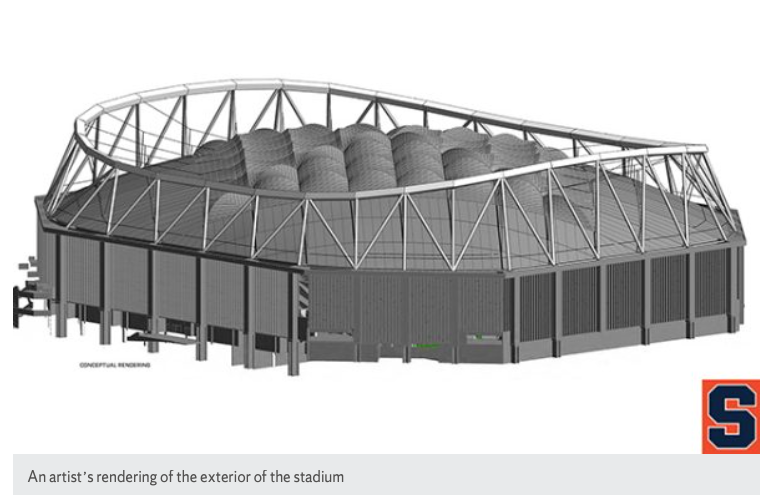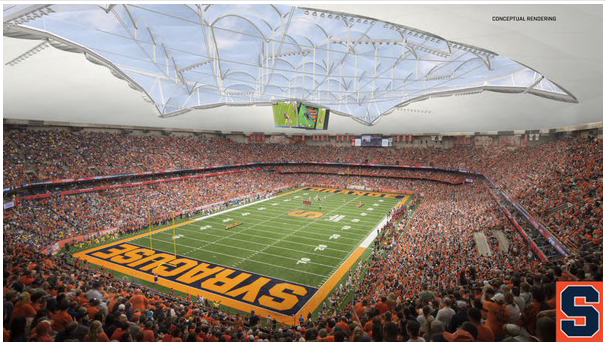- May 16, 2018
- Posted by: SportsV
- Categories: Home News, Industry News, News, Press Releases

A new fixed, cable-truss roof, a vertically-hung scoreboard, state-of-the-art sound and lighting systems, improved accessibility and added Wi-Fi capabilities are just a handful of features visitors to Syracuse University’s 49,250-seat Carrier Dome stadium will experience beginning in the autumn/fall of 2020.
The US$118m investment to what is the largest domed stadium on any college campus, has been authorised by the Board of Trustees and will enable Syracuse University to create a new stadium experience for students, faculty, staff, alumni and fans alike.
This latest announcement represents the next step in advancing the US$255m West Campus transformation strategy the University first announced on May 16, 2016.
Speaking at the May 14 announcement, Chancellor Kent Severed, said:
This is a great day for Syracuse University as we take a significant step in advancing the goals contained in our Campus Framework, a 20-year roadmap designed to align our vision and mission with our physical space.
Creating a new stadium experience is a key element to supporting a vibrant and diverse campus community. I am excited for our students—undergraduate and graduate—who will receive their degrees in front of their families and friends, for the student-athletes who will compete in this space and for the thousands of individuals who will visit our campus for athletic events, concerts and other activities.
The decision to move forward with this investment follows a comprehensive, multi-year review and assessment process. Over the last two years, members of the Board of Trustees, University leaders and other campus constituents have explored options for the future of an on-campus stadium, particularly as it relates to replacing the aging roof.
Since the University announced the Campus Framework in 2016, several initiatives that advance academic excellence and the student experience have been prioritised. Those priority initiatives have included more than US$27m in accessibility updates, classroom upgrades, learning technology enhancements and robust improvements to residence halls.
The University has also recently begun work on two signature projects: the Barnes Center at The Arch, a new state-of-the-art student-focused health and wellness complex that is a key component of transforming the West Campus, and the National Veterans Resource Center, which will allow the University to fulfill its promise of being the best place for veterans.
Amir Rahnamay-Azar, Senior Vice President & Chief Financial Officer, said:
In partnership with academic leaders, in particular the deans of the schools and colleges, we have made tremendous headway on several key initiatives over the last two years.
There is still more work to do. Our chief focus—both operationally and strategically—remains prioritizing initiatives that advance academic excellence, enhance the student experience and elevate our global research portfolio.

As part of the transformation of Carrier Dome – an almost 50,000-seat domed sports stadium – the University will invest more than US$6m in comprehensive Americans with Disabilities Act (ADA)-related accessibility upgrades. Among the improvements being made are a new accessible entrance, updating the current elevator to be ADA-compliant, five ADA electric door operators, the installation of closed captioning software and the addition of accessible seating, as well as other accessibility updates.
Diane Wiener, Director of the Disability Cultural Center, Co-chair of the Council on Diversity and Inclusion, and a member of the University’s Campus Facilities Advisory Board, said:
I am grateful that creating a space that all members of our campus community, as well as visitors, can safely and comfortably access is the University’s utmost priority. I am confident that with collaborative engagement with members of our disability community, most significantly our students, careful design and thoughtful construction, all students, faculty, staff and fans can enjoy the venue.
Other new features, designed to enhance the experience for all visitors that will be part of phase one include the installation of air conditioning, new accessible restrooms and new concessions space. These features are expected to be completed by the autumn/fall 2022.
Pete Sala, Vice President & Chief Facilities Officer in the Division of Business, Finance and Administrative Services, said:
Replacing the aging roof is really just the tip of the iceberg. The visitor experience will be completely transformed. From the enhanced natural lighting in the facility to the ease at which the scoreboard can be viewed, from the new lighting and sound systems to the added restrooms and concessions, our visitors can expect nothing short of a first-class experience. My team and I are eager to get this project underway and we look forward to providing our visitors an experience unlike anything they’ve had on our campus before.
John Wildhack ’80, Director of Athletics, said the announcement will be well received by many, including fans, current student-athletes and most definitely prospective student-athletes:
As the only stadium in the country that is home to five sports, including two women’s sports, this transformation is really a game-changer for Syracuse University athletics. The transformed facility will afford our coaches and athletics staff the tools necessary to continue attracting student-athletes who perform as well in their academics as they do in their respective sports.
I am especially thankful that the University will work closely with our department to limit disruption to our home athletic events. Though we’re still working through a timeline, we are hopeful that the impact on our teams will be minimal.
Jim Boeheim, Head Men’s Basketball Coach commented:
The results of this investment are going to make the Syracuse game experience even better for our fans and our players. The new construction will solidify our home court’s reputation as one of the top venues in college basketball.
Head Football Coach, Dino Babers, said he was pleased the University is maintaining one of the many elements that first attracted him to Syracuse University: an indoor, controlled environment:
Everyone in our program is ecstatic about the University’s commitment to ensuring our student-athletes and fans have the best experience possible while playing and watching sports in one of the most electrifying spaces in college athletics.
Leaders in the Division of Enrollment and the Student Experience say student-athletes are not the only group who will be excited by the latest Campus Framework announcement. In fact, Maurice Harris, dean of undergraduate admissions, says the campus transformation has already had tremendous impact on the University’s effort to recruit and retain a diversely talented student body.
Harris said:
Every year, we host campus tours and admissions events for more than 30,000 prospective students and their families at Syracuse University. This project, combined with other Campus Framework initiatives, will continue to positively impact our recruiting efforts. I am already seeing evidence that these initiatives are allowing us to attract and enroll high-achieving students interested in pursuing a world-class education in the geographic heart of New York State.
As construction gets underway on phase one initiatives, the University will begin scoping out potential phase two enhancements. In particular, the University is exploring ways to redefine the stadium’s footprint by connecting it—via an enclosed pedestrian thruway—to Archbold Gymnasium, ultimately creating a seamless navigational experience between the two highly visited spaces.
Be sure to visit http://campusframework.syr.edu for progress updates, photos and more.
Source & images, courtesy: Syracuse University

